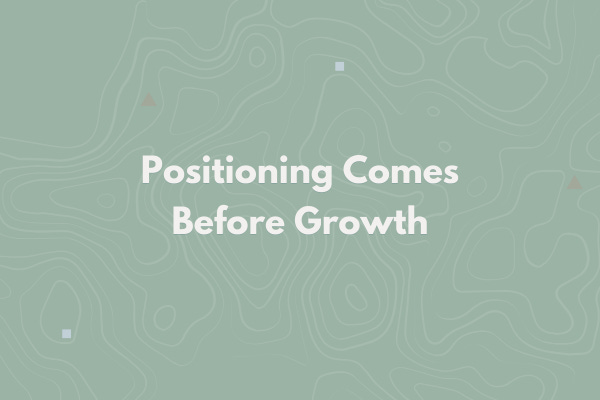Positioning Comes Before Growth
Messaging is what people notice. But when it falls flat, the problem usually isn’t the words. It’s the positioning underneath.
This shows up at every stage of a company. Startups pitch a big vision and end up sounding vague. Growth-stage vendors add more features and try to reach more buyers but lose the thread. In both cases, the message gets noisier, not clearer.
This is what happens when a pitch tries to speak to multiple buyer types, solve too many problems, and differentiate on everything at once. It sounds like it could apply to anyone, which means it resonates with no one.
That’s not a messaging issue. That’s positioning breaking down.
Positioning isn’t about how you describe your product. It’s about the decisions that shape what deserves to be in the story and what doesn’t.
If your story isn’t landing, these are the decisions most worth revisiting:
1. Get Specific About Who You’re Actually For
If your answer is “health plans,” you haven’t made a real decision yet.
Start with the line of business: Are you built for Medicare Advantage, Medicaid, Commercial, ACA, or Duals? Each one has its own operating model, pressure points, and performance metrics.
Then define the plan segment: Are you going after national payors, regional plans, Blues, or delegated entities like MSOs and IPAs? What works in one segment often falls flat in another.
Finally, get specific about the function you’re targeting: Stars, Risk Adjustment, Government Programs, Medical Management, Quality, Network. These aren’t just departments - they’re different mental models with different definitions of ROI.
If you don’t know exactly who you’re for, your prospects won’t either. And the broader your answer, the harder it is to build a message that actually moves someone.
2. Speak to the Problem Already on Their Desk
After you’ve defined your target buyer, the next step is to name the specific problem they are under pressure to solve. Not everything your product can do. Just the one thing that matters most right now.
This is where many vendor teams lose clarity. They list features, layer on soft benefits, and leave it to the buyer to decide what matters.
But buyers don’t do that work. They listen when the problem feels familiar and when your product clearly exists to fix it.
Claims like “improves outcomes, lowers costs, and drives engagement” don’t create urgency. They’re vague, interchangeable, and instantly forgettable.
Effective positioning starts by choosing one meaningful pain. Everything else should reinforce that choice.
3. Say What Makes You Hard to Replace
Many vendors try to answer this with feature lists or buzzwords like: AI-powered, Seamless, Scalable, Tech-enabled, etc.
But those words don’t carry weight. Not unless they point to a result the buyer actually values and one your competitor can’t easily claim.
Here’s the test: If a competitor can say it too, it doesn’t clarify why a buyer should choose your solution.
Weak positioning tries to sound impressive. Strong positioning signals to the buyer that this could be the fit they’ve been missing.
Real differentiation moves you from one of many to one worth serious consideration.
4. Define What You’re Not and Own It
Good positioning doesn’t just attract the right buyer. It filters out the wrong ones. And that’s what gives it power.
Clarity only comes when you're willing to close the door on other paths. The sharper you get, the more traction you earn.
Here’s one way to test if you’re getting closer: Try removing parts of your pitch and see if it gets stronger, not weaker. If every sentence in your message is still trying to please everyone, you’re not done yet.
By the way, this should feel uncomfortable. That tension means you’ve stopped trying to be everything and started being clear about what you’re best at.
Final Thought
Strong positioning doesn’t just make your message clearer. It makes your company easier to trust.
When the hard decisions are in place, everything gets simpler. Buyers understand what you do. Teams align faster. And the wrong opportunities stop showing up because you’re no longer inviting them in.
You’ll know you’re close when the message feels more focused than before and just uncomfortable enough to feel real.
It’s uncomfortable because it’s working. Keep making the hard calls.
🔒 Like This? Upgrade to a paid Subscription.
The free newsletter covers the big ideas. Paid subscribers get the full breakdowns, including client-tested strategy, behind-the-scenes examples, and deeper thinking you won’t find anywhere else.
→ [Become a Paid Subscriber]
About the Author
Ryan Peterson writes Upward Growth, where he shares practical insights on selling health tech into the payor market. With 15+ years in healthcare growth leadership, he focuses on helping vendors translate their value into traction with health plans.
🟦 Connect with him on LinkedIn.


